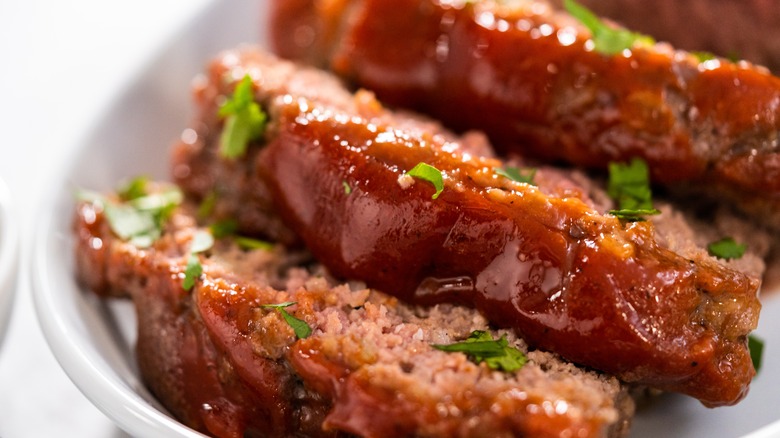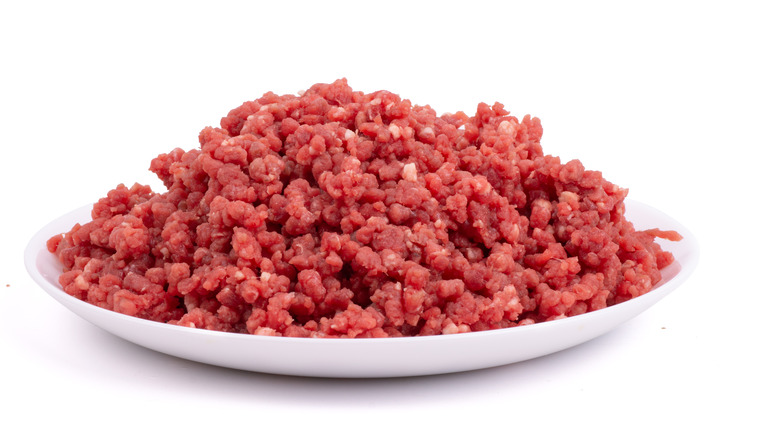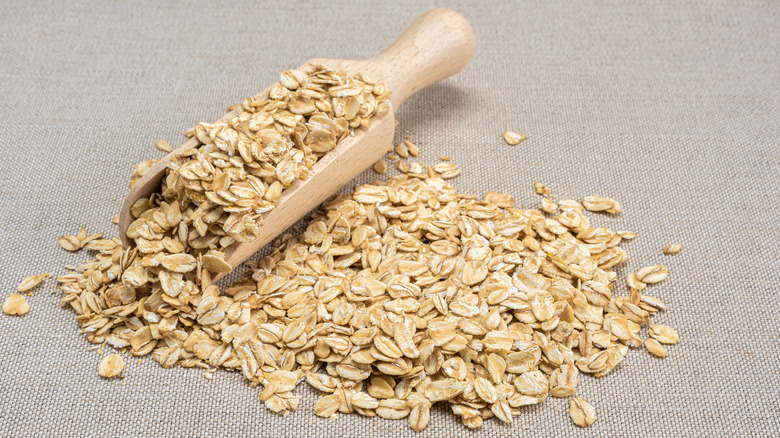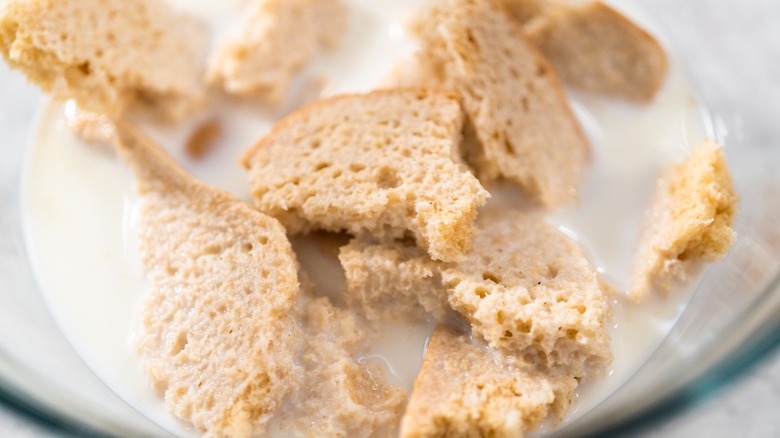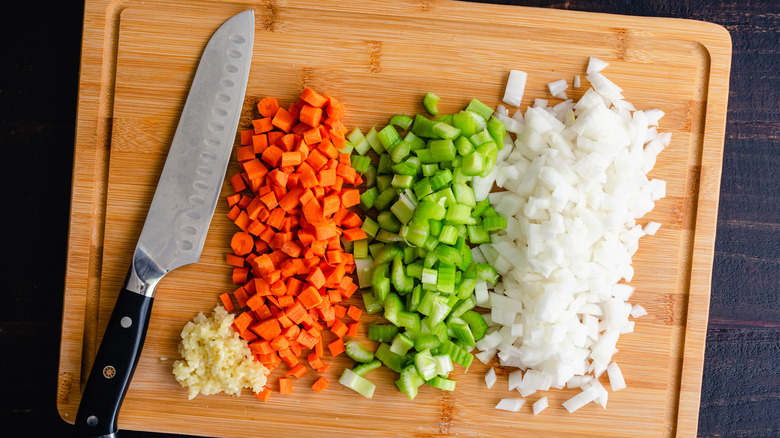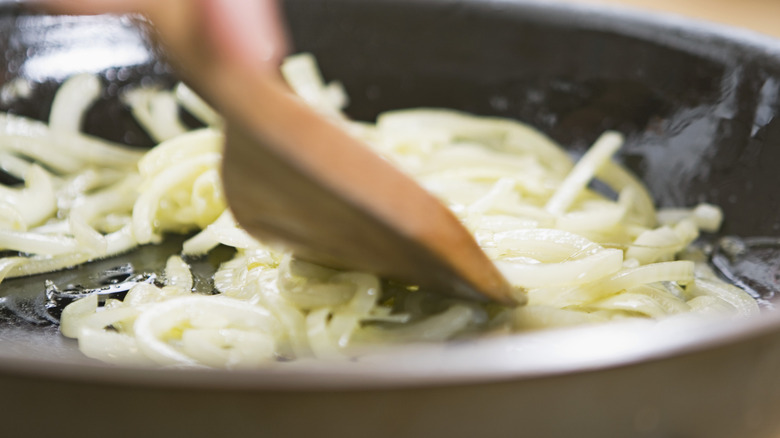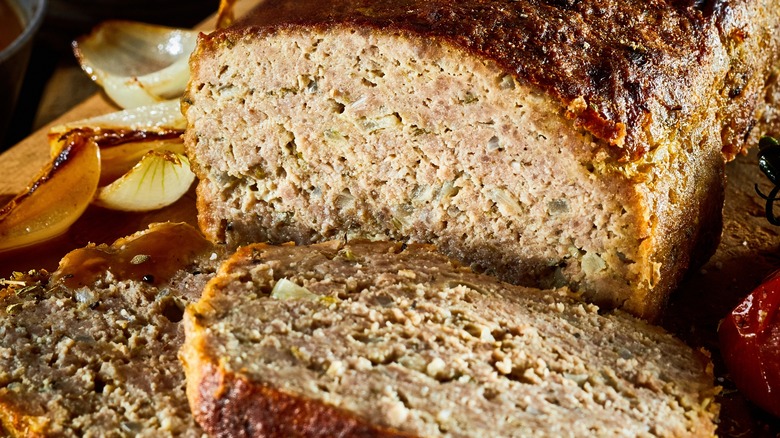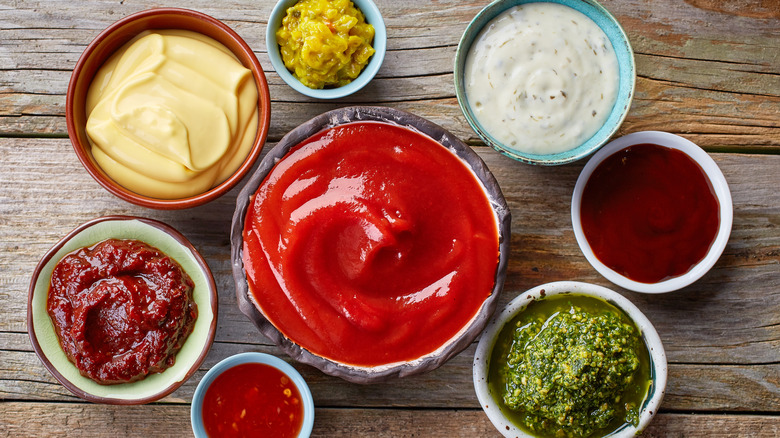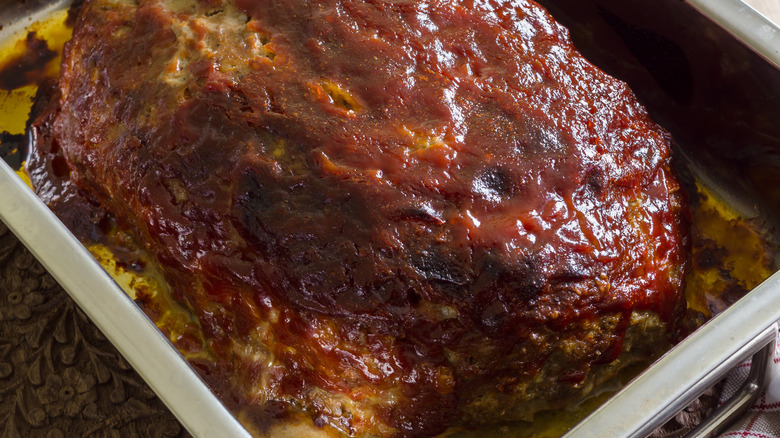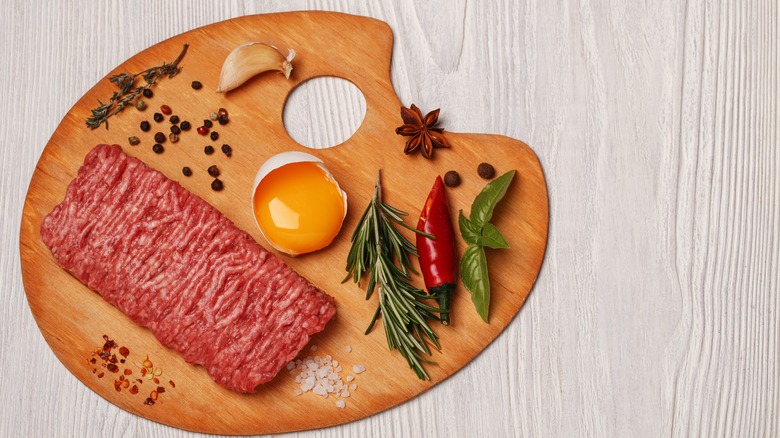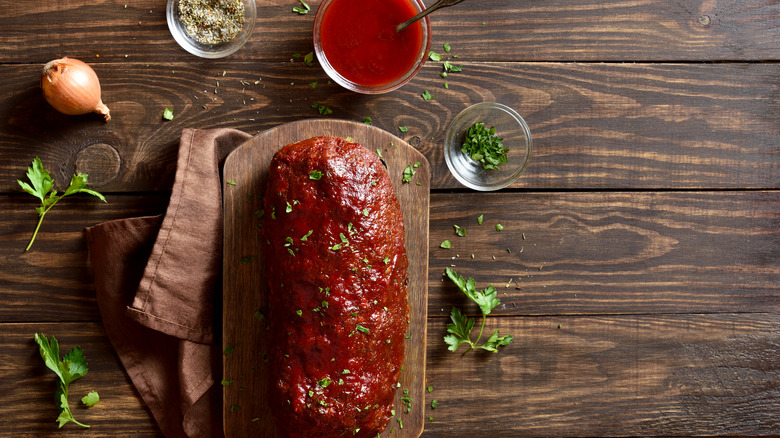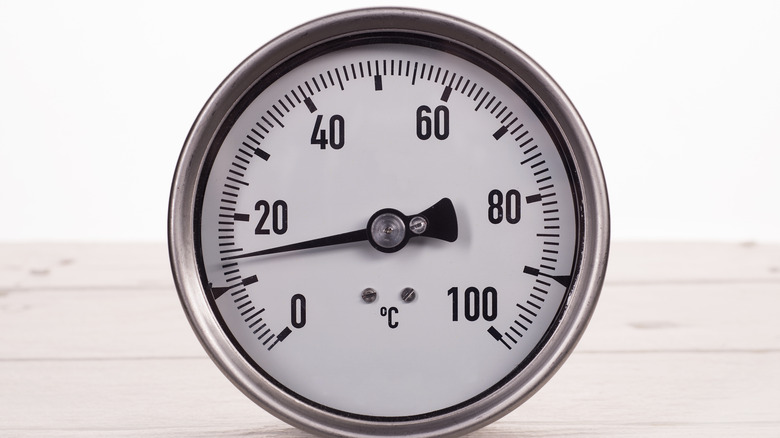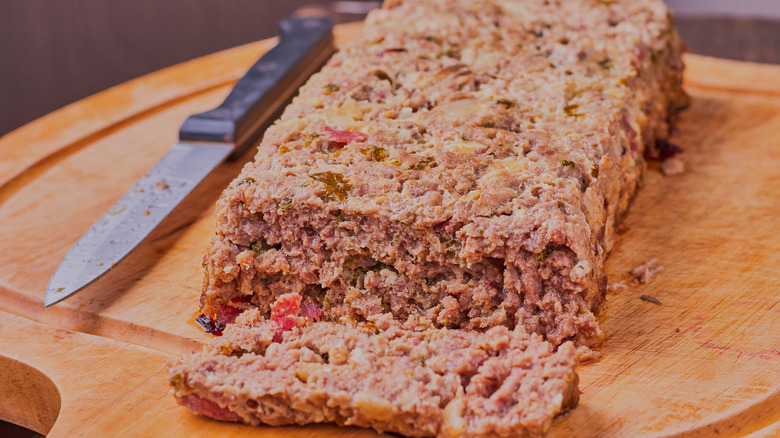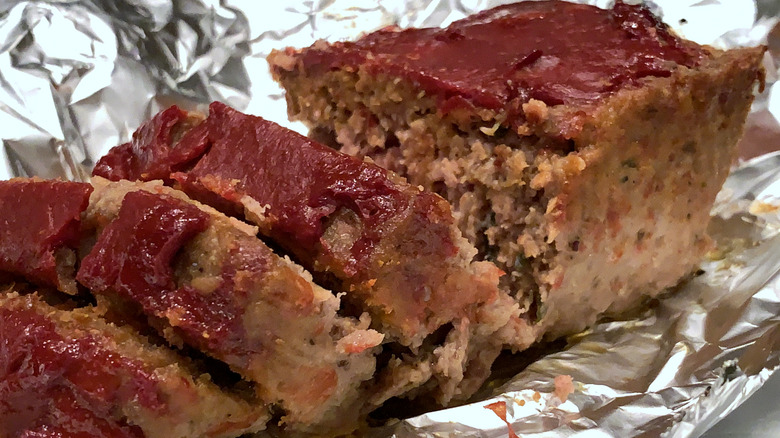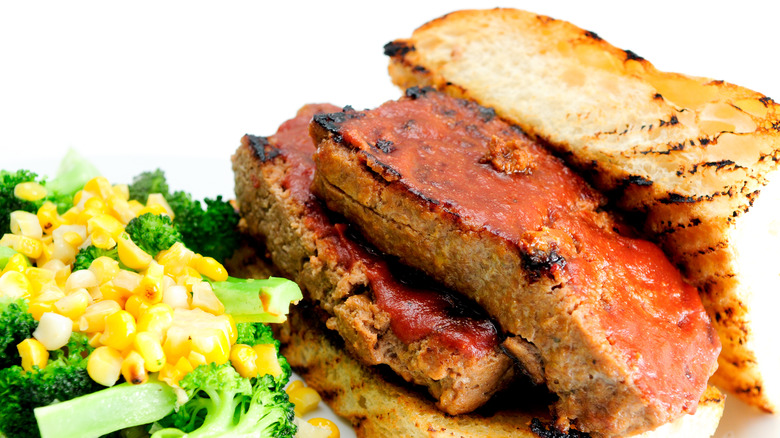The 14 Absolute Worst Mistakes You're Making With Meatloaf
Meatloaf is the epitome of a Sunday night dinner. Meatloaf rose to popularity in the late 1800s because the dish was comprised of relatively inexpensive leftover meat scraps and stale bread. Eventually, meatloaf was adapted to suit regional preferences and flavors; one variation that remains popular today is scrapple — a Pennsylvania Dutch meatloaf made with pork scraps (like pork head, liver, and offal meat), cornmeal, and flour that is pan-fried after baking. The "modern" meatloaf as we know it today was frequently eaten during both the Great Depression and the Second World War with the improved accessibility to meat grinders, as well as the proliferation of inexpensive home cooking recipe books.
As a dish, meatloaf is deceptively easy to make. Throw a hunk of ground beef, some dried herbs, and maybe an egg or two in a greased loaf pan and bake it — right? In reality, making a moist, tender, and flavorful meatloaf takes a lot of practice, and often trial and error. Here are some of the biggest mistakes you may be making with this family dinner classic.
Not using the correct blend of meats
The key to making a perfect meatloaf at home is starting with the right blend of meat. Meatloaf recipes can include everything — turkey, beef, veal, lamb, pork, and even chicken. You can typically purchase a "meatloaf mix" of ground meat at your grocery store that contains equal parts beef, pork, and veal. But even with this deceptively easy mix of meat, you may still find that your meatloaf isn't that "meaty" after all. When you're making meatloaf at home, you'll find that lean meat is not your friend. Turkey, for example, is very dry meat with very little flavor and very little saturated fat. If you make a meatloaf with solely ground turkey, the meatloaf will come out dry and unflavorful. On the other hand, beef has more saturated fat, but is missing the flavor component. The unsung hero to help alleviate your moisture and flavor woes? It's pork.
Pork is an essential ground meat to add to your meatloaf recipe. Pork rounds have especially high fat and flavor compared to other types of meat, which makes them a perfect addition to a homemade meatloaf recipe. Between a quarter to a third of your total meat mixture should be ground pork, but you can also consider adding ground pork sausage to your recipe for a unique (yet still fatty) flavor.
Using breadcrumbs instead of oatmeal
Breadcrumbs are a staple ingredient in meatloaf. But the reality is, unless you prepare your breadcrumbs perfectly and cross your fingers, your meatloaf will still come out dry. Instead of using breadcrumbs for your meatloaf, you should try using oatmeal. The oatmeal locks in moisture in your meatloaf better than breadcrumbs and will keep the loaf together. Rolled oats are also an ideal binder for a gluten-free meatloaf, or a good alternative if you find yourself running low on breadcrumbs. Since meatloaf has a relatively fast cooking time, you should use quick rolled oats in your meatloaf to ensure that the oatmeal will be cooked by the time you remove the loaf from the oven.
Besides texture and moisture, oatmeal has numerous health benefits not shared by breadcrumbs. According to Healthline, oats contain a soluble fiber called beta-glucan that promotes satiety and can increase the diversity of gut flora in your body.
Forgetting to soak your bread
The type of starch called for in meatloaf recipes can vary. Some recipes stick to using crackers, breadcrumbs, or oatmeal while others call for stale bread. These ingredients are important to ensure that the loaf stays in a slice when it is cut and helps promote moisture retention to keep the loaf soft. If you are working with a recipe that calls for stale bread, you may be skipping a crucial step — soaking your bread before adding it to the meatloaf.
Adding stale, unsoaked bread to the meatloaf can suck up the rest of the moisture in the meatloaf. The result is a dry, crumbly meatloaf rather than a moist one. Luckily, this step can take only a few minutes of your time. Simply crumble your stale bread in a bowl with milk, or stock for a dairy-free option. Then, work the spongy bread into the rest of the meatloaf ingredients to ensure that the bread is evenly distributed.
Omitting vegetables from the mix
Although the name "meatloaf" may not cause you to run to the produce drawer of your refrigerator, it should. Adding vegetables to your meatloaf can prevent dryness and provide more diverse textures to an otherwise monotonous meal. If you want to stick to the classics, you can consider adding finely chopped onions, celery, and carrot to your meatloaf. Although these three ingredients (called a mirepoix) might not bring the flavor, you will be pleasantly surprised to see the textural contrast in your meatloaf. Other unexpected vegetables to add to your meatloaf include diced bell peppers; the burst of sweetness and color from these peppers is unmistakable in meatloaf.
Mushrooms are another potential addition to your meatloaf. Although classified as fungi, mushrooms can provide some of the same organic flavors as other vegetables — just with the added hint of umami. For a more intense woodsy mushroom flavor, consider cremini, porcini, oyster, or chanterelles. If you want to stick with a more mild mushroom flavor, white buttons are a widely-available mushroom found in the produce section of most grocery stores.
Adding raw vegetables to your meatloaf
You might be so excited to make your meatloaf that you forget (or intentionally skip) a crucial step — cooking the vegetables. Raw vegetables and meatloaf don't mix for several reasons. Raw vegetables are crunchy, so adding chunky carrots or stringy celery to your meatloaf can result in a textural nightmare. Even if you figure that the meatloaf will cook for an hour in your oven, this time is not enough to allow your vegetables to cook all the way through and soften. Plus, cooking the vegetables before adding them to the meatloaf will enhance the sweetness and flavors that the vegetables bring to the table anyway.
The cooking time required for your vegetables depends on the kinds of vegetables you use. Carrots are notoriously crunchy, so chopping the carrots into super-small pieces can help speed up the cooking time needed. If you're using bell peppers, you can consider charring them on the grill with the onions to add a more smokey flavor to your meatloaf.
Under-seasoning the meatloaf
Meatloaf can be bland, depending on the mixture of meat (we're looking at you, ground turkey) and sauces you use. To help your meatloaf out, you're going to need to add a lot of seasonings and herbs to help carry the meatloaf's flavor. Fresh chopped sage and rosemary are two examples of herbaceous ingredients that impart organic notes onto the meatloaf. If you don't have access to fresh herbs for your meatloaf, don't fret.
Dried herbs can improve a meatloaf's texture and save you a couple of dollars. But, you should know that dried herbs and fresh herbs are not equivalent. Fresh herbs are far less potent in flavor than their dried counterparts, so you may find yourself using one teaspoon of dried herbs for each tablespoon of fresh herbs in a recipe. Fresh herbs can provide a pop of color and fresh flavor to the dish before it's about to be served while dried herbs have the greatest utility in being mixed in at the start of a recipe.
Forgetting to add moisturizing ingredients
The key to a moist meatloaf is in the sauce. Too often, home cooks forget to add moisture to their meatloaf, which results in a dry, crumbly mess that looks anything but appetizing when you're trying to serve it. If you want to upgrade the moisture level in your meatloaf, you don't have to look much further than the condiment section of your refrigerator. We recommend adding a squeeze of ketchup to your meatloaf or for a smokier flavor, add a bit of barbecue sauce instead. You won't have to worry about either of these ingredients evaporating because of their high viscosity.
For folks who don't mind a slightly fishy flavor, add a few tablespoons of Worcestershire sauce to your meat mixture. The tamarind and the fermented anchovies play off the ground meat and offer a more mature flavor. If you're feeling adventurous, you can add a bit of salty soy sauce or fish sauce to your meatloaf for savory notes — just be wary of adding other salty ingredients to prevent your meatloaf from becoming inedible.
Omitting a sweet element in your meatloaf
Becoming a great cook is all about being to master and complementing the flavors of salty, sweet, umami, sour, and bitter. Adding a sweetener to your meatloaf will make your meatloaf more complex and help balance out the salty flavors that can easily overpower a simple dish like meatloaf. The type of sweetener used in meatloaf usually depends on the recipe; some will add brown sugar, honey, or maple syrup to the meat mixture directly. But an unexpected sweetener that acts as the Swiss Army knife of meatloaf flavorings is ketchup.
Ketchup is often added to meatloaf because it includes a sweet component, often granulated sugar, along with an acid (vinegar) and umami (tomato paste). You can add ketchup to meatloaf a little bit more safely than other sugars because it rarely overpowers other ingredients with its sweetness. If you go with the brown sugar or liquid sweetener route, you'll have to be a bit more careful because the sole element these ingredients provide is sweetness.
Not using a binding ingredient to keep your meatloaf together
Meatloaf needs a couple of ingredients besides meat, starch, and seasoning. A binding ingredient is critical to keeping the meatloaf together as it bakes and when it is cut into slices. Forgetting the binder may mean that your meatloaf falls apart and doesn't have a perfect consistency.
Eggs are common binders in meatloaf recipes. The yolk contains fats and proteins that help keep the meatloaf moist while the white provides the structural components that make the meatloaf stick together. Try using a ratio of one egg for every pound and a half of meat for the perfect meatloaf consistency. You should lightly beat your eggs before adding them to the meatloaf with the other seasonings, sauces, and starch. Lightly beating the egg adds some air into the mixture and allows the yolk and the white to better mix with the other meatloaf ingredients.
Skipping a glaze
To glaze or not to glaze, that is the question. Glazes are commonly used in meatloaf for flavor and to help seal in the moisture of the loaf. Ketchup is a common glaze for a classic meatloaf; you should plan to brush ½ cup of ketchup to the top of the meatloaf before placing it in the oven. Baking it without tin foil on the top will result in a slightly crispy ketchup glaze that provides a hint of caramelized sweetness. You can also make a more unconventional meatloaf glaze by incorporating barbecue sauce into the meatloaf's glaze. This rendition is a bit more savory than the ketchup, but you will get some of the sweetness that you would from using a ketchup glaze instead.
If you feel like going off the deep end with your glaze, you can also try making a glaze with help of another American classic: bacon. You can wrap your meatloaf in bacon and glaze it with a quick blend of brown sugar, Worcestershire sauce, vinegar, cumin, and unsalted butter.
Not cooking the meatloaf to temperature
Bringing your meatloaf up to an internal temperature of 160 degrees F is important, from both a food safety perspective and a texture perspective. Meat can harbor dangerous foodborne illnesses that can make us sick. Heating ground meat to the proper internal temperature (taken with a thermometer in the middle of the loaf) ensures that no one will get sick from eating your meatloaf. You cannot tell the doneness of meat based on look alone, so you should always have a meat thermometer handy.
Meatloaf cooks low and slow. The ideal oven temperature for cooking meatloaf is around 350 degrees F. Cooking the meatloaf at a high temperature will evaporate the moisture quicker and result in a drier loaf. We recommend checking the temperature of your meatloaf about 15 minutes before you expect it to be completed cooking. Open the oven marginally to avoid letting all the heat out and check the temperature in the thickest part of the meatloaf.
Not resting the meatloaf once you pull it from the oven
If you're running on a busy dinner schedule, your prerogative might be to pull the meatloaf out of the oven and slice it quickly to ensure that everyone at your table is fed and happy. But not so fast — meatloaf needs to rest to ensure the best texture.
You should always let the meatloaf rest after removing it from the oven for about 15 minutes. This window of time allows the muscle fibers in the meat to reabsorb the juices released during cooking. You should also cover your loaf in foil to prevent too much moisture from escaping from the loaf as it rests. Besides a moist texture, letting the meatloaf rest before slicing means that you will get cleaner margins when you go to slice your loaf. And now with 15 extra minutes, you can spend more time on your sides. May we suggest garlic mashed potatoes?
Incorrectly storing your meatloaf
Cooked meatloaf lasts around three to four days in the refrigerator. The ideal way to store meatloaf is to wrap it in aluminum foil or plastic wrap or stick to a simple air-tight container. You can also wrap the cooked meatloaf in foil, place the loaf inside a freezer bag, and freeze the loaf for up to four months. If you plan to eat the meatloaf over a long period, you can freeze individual servings of the meatloaf so you can thaw it in your refrigerator the night before. It's a good idea to freeze the meatloaf in some sort of sauce to prevent it from getting mushy when it's thawed.
Once you thaw meatloaf, you should plan to eat it. Like other types of meats, reheating and refreezing meats can cause a food safety issue, as well as alter the texture of the meatloaf. If you leave your meatloaf at room temperature for more than two hours, you should toss it rather than freeze it.
Not making the most out of your leftover meatloaf
There should never be a reason to groan when it comes to leftover meatloaf because there are so many different ways you can repurpose leftover meatloaf into new dishes. If you like to keep it simple, you can slice the meatloaf into thin pieces and make meatloaf sandwiches on ciabatta rolls with tomato jam, lettuce, and homemade aioli. If you want to deconstruct the meatloaf, you can crumble it into a bowl and use it as meat for tacos, a bolognese sauce, or as a filling for stuffed peppers.
When you use meatloaf crumbles for recipes, you should note that reheating the meat in a skillet not only brings it up to temperature but also adds a bit of crunchy texture to the meat as its cooking. Naturally, heating the crumbled meat in a skillet will release some of the moisture from the loaf. Consider adding a bit of broth, stock, water, or wine (depending on your recipe) to help keep the meat moist — especially if you went through all this trouble to make your meatloaf as moist as possible.
